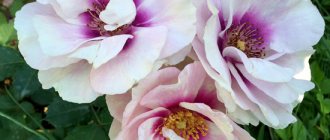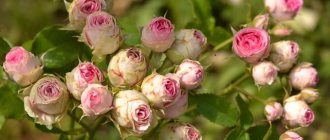Rose Jazz - what kind of variety is it
This crop is considered new. It was bred by German breeders in 2003. Despite its young age, the variety managed to gain great popularity all over the world.
The culture is distinguished by lush flowering
Brief description and characteristics
The variety's resistance to frost makes the rose in demand among Russian flower growers. The plant can be grown even in the Moscow region. Rose is not afraid of a little freezing as it quickly recovers. In general, it is characterized by increased resistance to bad weather.
Flowering continues throughout the season without interruption. The number of flowers on the stems can reach 10. The buds themselves are small in size and do not exceed 3-4 cm in diameter.
At the initial stage of flowering, the buds have an orange-copper color. As they bloom they take on a peach color. In any case, the rose perfectly fulfills its decorative functions.
For your information! Rose Jazz is a shrub covered with many small flowers of bright colors. The plant reaches a height of 70 cm, the width of the bush is 45 cm.
Advantages and disadvantages of the variety
The description indicates the following advantages:
- ease of care;
- disease resistance;
- resistance to harsh climates;
- no need for constant pruning;
- independent shedding of flowers.
At the same time, the variety also has certain disadvantages:
- need for partial pruning;
- the presence of prickly thorns;
- poor development of bushes in the shade;
- the need for periodic application of fertilizers.
Use in landscape design
The ground cover rose Jazz is actively used in landscape design. It is grown in flowerpots outside and planted in flower beds. It can serve as a decoration for parks or garden plots.
Features of agricultural technology
“Jazz” is easy to care for, like all ground cover roses, since it does not require constant pruning and mandatory feeding.
Expert opinion: “Ground cover roses do not require pruning - this is a common feature of all varieties of this group. You just need to do spring sanitary cleaning, removing diseased, frozen and damaged stems. You can shape the bush to your liking: into a cube, a cone, a ball, or a spreading scrub. Of course, a ground cover rose will tolerate any pruning, but since radical pruning provokes the powerful formation of new young growth, it will need a lot of nutrients to recover. The rose will bloom with minimal care. However, after balanced feeding, the bush usually grows to enormous size. (see → How to feed roses) This is how the plant thanks for the “food”. The rest of the care, disease prevention, watering, pest control are standard, as for other varietal groups.”
Elena Demyanchuk is a rose grower with 20 years of experience, the owner of the largest collection of roses in the Moscow region.
Growing a flower: how to plant it correctly in open ground
The plant has excellent decorative properties. To achieve success in its cultivation, you need to carry out planting work correctly.
Rose Chippendale - characteristics of the varietal shrub
The plant is recommended to be propagated by seedlings. In order for the rose to grow normally and delight you with its decorative effect, it is best to buy planting material from trusted nurseries.
Important! The seed method is used only by breeders, since it does not allow preserving varietal characteristics.
Experienced gardeners recommend planting the plant in late spring. This must be done after the soil has completely warmed up.
Selecting a location
A sunny area that is protected from the wind by other plants is suitable for planting. Roses need light and fertile soil.
How to prepare the soil and flower for planting
Before planting, the plant must be soaked in a growth stimulator. On the site you need to make a square hole measuring 60 by 60 cm. You also need to mix a mixture based on sand, clay, peat, humus, garden soil and make a hole in it. You can add superphosphate and ash.
Step by step landing procedure
To plant a plant you should do the following:
- Place the seedling in the hole and straighten its roots.
- Gradually sprinkle the rose with soil and compact the soil.
- Hill up the rose and fill the trunk circle with water.
- Sprinkle it with sawdust and dry bark.
Important! The plant should be watered moderately for several days. Otherwise, there is a risk of active development of above-ground shoots against the background of undeveloped roots.
When planting, you need to observe a number of features
Common mistakes rose growers make
- As you know, under the scorching rays of the sun, roses quickly fade, the color of the buds fades, and the petals “burn.” For this reason, some gardeners plant rose gardens near the walls of buildings or under the spreading crowns of trees. This proximity protects roses from heat and wind . The main mistake of inexperienced gardeners is not maintaining an acceptable distance between rose bushes and large plants. Trees with a developed root system take away moisture and nutrients from roses. The stems weaken, become thinner, blind shoots form, and the risk of fungal diseases increases. The roots of roses planted closer than 0.5 m to concrete wall foundations freeze in winter.
- The indicator of soil moisture and the depth of groundwater are essential characteristics when choosing a location for setting up a rose garden. Excess moisture in the soil increases acidity, impedes the access of oxygen, and overcools the roots of the plant during wintering. In areas where there is stagnation of moisture, even for a short time, gravel or crushed stone laid at the bottom of the planting hole is indispensable. The drainage pad softens, but does not completely solve the problem of excessive soil moisture. To drain water from the roots of roses planted in a waterlogged area, it is necessary to lay drainage pipes.
Tip #1 : Roses will not suffer from stagnant melt water if you create a kind of podium for planting them, that is, raise the rose garden 50-60 cm above the general ground level.
Plant care
In order for the plant to develop well and look as attractive as possible, you need to adhere to certain rules when growing it.
Watering rules and humidity
Rose Pilgrim (The Pilgrim) - characteristics of the varietal shrub
Once a week, the bushes should be watered at the root. It is recommended to perform the procedure early in the morning and use warm water. During drought, the amount of watering is reduced.
Fertilizing and soil quality
The variety is characterized by rapid growth, and therefore it needs to be systematically fed. In this case, you should adhere to the following scheme:
- in early spring, apply nitrogen agents;
- then use formulations based on potassium and sodium;
- Finally, phosphorus fertilization is carried out.
Pruning and replanting
It is not recommended to prune roses frequently. In the first year, it is enough to lightly trim the ends of the shoots. Then you should remove dry branches and thin out slightly to maintain shape. It is important to maintain a distance of 1 cm from the kidney.
Note! To avoid infection, the cuts must be treated with garden varnish.
Features of wintering a flower
The variety is highly resistant to frost. It can be easily grown in the Moscow region without shelter. Even if the shoots freeze slightly, the plant quickly recovers.
Origin
Rose grandiflora (grandiflora)
The first of these is Just Joey (1972). Its author, Roger Posey, is the son of one of the owners of the company. Having crossed two CG roses - the famous Fragrant Cloud (Duftvolke) and the yellow fragrant 'Dr. AJ Verhage' (originator Gysbert Verbeek, 1963), he received a beautiful flower, devoid of any flaws.
The breeder decided to name the rose in honor of his wife, Joey Posey. However, considering that her name did not sound too melodious for such beauty, he asked her for advice. Not at all offended, the wife said: “Just call her Joey.” That’s how the rose came to be called “Just Joey – Just Joey.”
Description
The plant forms a well-branched lush bush with a height of 75 to 120 cm and a width of up to 120 cm. The leaves are leathery, glossy, dark green in color, and medium in size.
The rose is remontant and blooms profusely and for a long time. Elegant conical buds (8-10 cm), salmon-orange in color, gradually open into a huge double cup-shaped flower up to 15 cm in diameter. The ruffled petals are amber yellow with a copper tint, with a slight blush on the reverse side.
Unusually beautiful in any phase of dissolution, single flowers, only occasionally collected in a brush, have a strong, rich fruity aroma, reminiscent of the smell of melon and orange. Just Joey has enviable health, is resistant to powdery mildew and black spot and comes out of winter well. The flowers are very resistant to wet weather, and the buds bloom even after prolonged rains.
Agrotechnical features
Just Joey is designed for gardening in 7b to 10b USDA zones. But, according to the observations of flower growers, it develops better in cool climates: the flowers have a brighter color, and their aroma intensifies. In hot weather, they quickly fade, so you need to select a planting site taking this feature into account.
Otherwise, caring for the magnificent “Just Joey” is no different from the standard for roses of this group.
World recognition
Ideal beauty, unusual flower color, and endurance have made this rose very popular in the world. She has won prestigious awards at numerous competitions and exhibitions. It started with a rose testing certificate obtained in Hamilton (New Zealand) in 1975.
The James Mason 'Just Joey' Medal of Honor was awarded in 1986 by the Royal Rose Society of Great Britain. It is awarded to varieties of roses that have enjoyed particular success among gardeners over the past 20 years.
In 1993, the rose received the prize of the Royal Horticultural Society (AGM) as a plant recommended for cultivation in England.
In 1994, Just Joey took pride of place in the World Federation of Rose Societies (WFRS) Hall of Fame list as the world's favorite rose.
In 1999-2001, she was twice awarded the title of "Show Princess" and "Queen of Show" by the American Rose Society (ARS).
In 2001, the rose received an Honorary Prize at an exhibition in the USA from the Austin Rose Society. This is how she is “Simply Joey”, the rose is perfection itself: its flowers with a divine aroma, on long shoots, are equally charming both in a flowerbed in the garden and in the interior of a room.
Rose blossom
Rose Pomponella - characteristics of the varietal shrub
The rose has excellent decorative properties. That’s why it is often used to decorate a site.
Period of activity and rest
The plant blooms almost all summer, decorating the flower beds of the site. With the arrival of cold weather, the flower begins a period of dormancy.
Care during and after flowering
During the formation of buds, potassium and sodium are used. After flowering ends, the bushes should be fed with phosphorus and potassium products.
What to do if it doesn't bloom
The lack of flowering is due to the following factors:
- incorrect choice of landing site;
- nutritional deficiencies;
- incorrect watering mode.
Application in landscape design
The plants are great for creating beautiful floral displays in your lawn. They are also used as decoration for flower beds or paths, where plants with a neat and compact flowering pattern are best suited.
This type of rose is planted in rose gardens near other plants to create various compositions. You can often find low-growing roses that are planted near stones. Later, a beautiful rock garden appears.
Creeping roses will fit well into the interior of stone buildings and multi-level gardens. Also, ground cover varieties can be planted in flowerpots, hanging baskets, and used to decorate walls. The characteristics of low-growing roses are used with pleasure by professional landscape designers and amateur gardeners.
Flower propagation
Most often, roses are propagated by cuttings or layering. The variety cannot be propagated by seeds.
Important! It is recommended to root shoots in early March.
To propagate roses near the bush, you need to make long trenches and lay straight shoots in them. The branches should be secured with pins and sprinkled with soil. With systematic watering, roots appear quickly. Next spring, the shoot needs to be separated and planted in a permanent place.
Roses can be propagated by layering
Answers to flower growers' questions
Question #1: Is it necessary to mulch the soil under ground cover roses?
- cut grass (preferably mature);
- humus, peat or peat-compost mixture;
- last year's (by no means fresh) sawdust and shavings;
- conifer bark.
Tip #2: Rotted manure and bird droppings are not only useful organic fertilizer for roses, but also excellent mulch. The bushes are covered with such mulching material in early spring. Autumn application is not advisable so as not to overheat the plant’s root system.
Question No. 2: What partners are suitable for proximity to the Jazz rose?
Traditional neighbors of ground cover roses in group plantings in flowerbeds and mixborders:
Popular varieties for Russia, Belarus and Ukraine
All the varieties of ground cover roses listed above in this article feel great in our climatic conditions. Below we list the names of the varieties that are most popular, have good planting survival rate, have high winter hardiness, resistance to diseases, are unpretentious in care, seedlings of which can be easily purchased in stores and nurseries:
- white - Aspirin, Pearl Meyandekor, Sunny, Kastelruter Spatzen, Snow ballet, Sveny. Ivery Drift
- yellow - Sonnenschirm, Annie Dupre, Nadia Meyandekor, Vacation, Augusta Louise (with orange border);
- pink - Penny, Palmengarten Frankfurt, Fairy, Lovely Fairy, Crazy, Rosita, Four Seasons, Topolina, Bayernland Carpet;
- orange - Paul Cezanne (bush floribunda), Ethiopia, Fensie, Apricot Clementine; Ninette;
- peach, cream - Pat de valur,
- red - Hello, Alpengluchen, Scarlet Meyandekor, Rouge Meyandekor, Cherry Girl, Meidi (with white lining), Rody; Nostalgia.
- crimson and purple - Purple Hayes, Purple Rain, Red Fairy, Prodige Ekarlat. Tornado.
By choosing ground cover roses, you are guaranteed to free yourself from unnecessary care hassle and become the owner of regal bushes that bloom intensively all summer long.
Ground cover roses and their cultivation
Diseases, pests and ways to combat them
Sahara is quite resistant to various lesions, however, improper care and unsuitable conditions can lead to diseases of the root system and the entire bush.
Aphids and other pests also pose a danger. You can get rid of lesions using special antibacterial and antifungal agents. If desired, you can use folk recipes.
The Sahara rose is a beautiful plant that will fit perfectly into any landscape design. The bush does not require special care, suitable even for beginners. It is not difficult to propagate a flower, the main thing is to follow all the necessary rules.
Diseases
Does the rose have a gray-white coating or brown balls on the leaves? Methods to combat the disease. Powdery mildew
Black spots of a round shape have appeared on the leaves of the rose, what should I do, how can I save the plant? Black spot
The rose is sprinkled with yellow powder, the leaves and stems crack and die, how to get rid of the disease? Rust
Has a gray coating appeared on the rose? This is gray rot that needs to be gotten rid of as soon as possible. Gray rot
A rose will entwine an ugly pillar and turn it into a fabulous garden decoration. Rosanna can be planted near gazebos so that she can weave along their walls. The flower also looks good in separate rose gardens; the tall stems are intertwined with each other in the form of a solid green cap with bright roses.
Pests
Microscopic spiders have appeared on the plant, and the rose is gradually becoming covered with cobwebs, what should I do? Spider mite
Are small green insects destroying your rose? Effective methods of pest control. Green rose aphid
Caterpillars have appeared on the rose and are twisting the leaves of the plant, how to deal with the pest Rosen leaf roller
Flat bumps have appeared on the shoots of the rose or on the underside of the foliage, how to deal with the pest Rosen scale insect
Mole crickets have appeared in the garden, this is very dangerous for your flowers, find out how to drive away the pest Mole cricket
Several sources of foamy liquid have been observed on the rose bush; this is a dangerous pest.
- Frost resistance;
- Disease resistance;
- Decorative qualities;
- Unusual decoration of landscape design;
- Tall, powerful stems with abundant dark green foliage;
Flaws:
- Weak aroma;
- Does not tolerate rainy weather well;
- Not a compact shrub.
The best varieties and their characteristics
More and more gardeners, when designing their own rose garden, are paying attention to ground cover roses. Among the many well-known varieties, several names are recognized as the best for our climatic zones, according to reviews of Russian flower growers
- "Ahtiar" is a large white rose that blooms once per summer, but with a very long flowering period. A tall bush with flexible drooping branches up to 1.5 m long is used to decorate green hedges or borders, but can be grown in standard form.
- 'Fair Play' is a semi-double rose with flowers ranging from pale pink at the base to fuchsia at the edges and has a light scent. A bush with drooping one and a half meter vines in height can also reach a length of 1.5 m. It blooms up to three times during the summer.
- “Fiona” (Fiona) - a pink-red double flower with a diameter of 70-80 mm, collected in inflorescences, on a tall bush with drooping shoots pleases with continuous flowering from the beginning of summer until the first frost.
- “Hello” is a low creeping bush with large, densely double flowers that change color from dark red to deep cherry, can withstand frosts down to -30°C. The odorless flowers have the densest plumage of all varieties of ground cover roses.
- “Ballerina” - simple flowers with a transition from white in the center to pink at the edges, collected in lush inflorescences, have a delicate aroma with a slight musky note. During flowering, the size of the flowers increases. Tall bushes with drooping branches form a spherical shape.
- “Scarlet” - a red double rose on a low bush with dark glossy foliage is recognized as one of the most adaptable and resistant varieties.
In addition to the varieties listed, the most beautiful of ground cover roses also take root and bloom well in Russian open spaces.
- “Amber Cover” is an amber-yellow rose with large semi-double flowers that smells pleasantly of rose hips. On a tall bush among dark green foliage, spherical flowers look gorgeous.
- “Jazz” is a self-cleaning bush with small semi-double flowers of beautiful colors: copper-orange at the beginning of flowering, gradually acquiring a peach color. Abundantly flowering bushes are well suited for massifs, but can be grown either in small groups or in narrow plantings.
- “Swany” - white with a soft pink center, dense double flowers of the best variety of ground cover roses bloom on a low spreading bush with small evergreen leaves. Thanks to the shape of the bush, the rose looks good on slopes or on a trellis. Blooms up to three times during the growing season.
But each gardener chooses the flowers that he likes, so for some, completely different varieties of roses will be the best. The main thing is to choose the right variety in accordance with the place where the flowers will grow.











